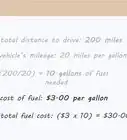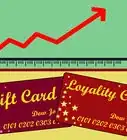This article was co-authored by Jill Newman, CPA. Jill Newman is a Certified Public Accountant (CPA) in Ohio with over 20 years of accounting experience. She has experience working as an accountant in public accounting firms, nonprofits, and educational institutions, and has also honed her communication skills via an MA in English, writing jobs, and as a teacher. She received her CPA from the Accountancy Board of Ohio in 1994 and has a BS in Business Administration/Accounting.
There are 8 references cited in this article, which can be found at the bottom of the page.
wikiHow marks an article as reader-approved once it receives enough positive feedback. In this case, 85% of readers who voted found the article helpful, earning it our reader-approved status.
This article has been viewed 1,151,493 times.
Running a restaurant, catering service, or culinary school can be an expensive and complex undertaking. To make sure your business stays afloat, you must make regular and accurate calculations of your food costs. There are three main calculations you need to stay on top of: the maximum allowable food cost (which tells you how much you can afford to spend); the potential food cost (which tells you how much your menu costs); and your actual food cost (which tells you how much food you're ordering for your business). Comparing these three figures will help you make the adjustments and tweaks that ensure your business' long-term success.
Steps
Sample Calculators
Calculating Maximum Allowable Food Cost
-
1Understand why you need this calculation. The maximum tells you what percentage of your business's operating budget can be allotted to food cost for the operation to still turn a profit. Without knowing this number, you won't be able to tell whether your actual food cost (calculated in a later section) is on target to produce your desired profit margin.
-
2Begin by calculating your operating budget. Your company's operating budget is the sum of your current and projected expenses, and your projected profit. To calculate the month-to-month operating budget, you need to keep the following amounts in mind:[1]
- Target profit
- Hourly labor (servers, dishwashers, etc.)
- Salaried labor (managers, owners, head chef, etc.)
- Utilities (gas, electric, water, wifi, etc.)
- Fixed costs (rent, mortgage payments, insurance, etc.)
- Fees and licenses (taxes, liquor license, business license, food handling permits, etc.)
- Supplies (cleaning supplies, non-food cooking supplies, plates, carryout packaging)
- Marketing
- Maintenance
Advertisement -
3Determine how much money you can afford to spend each month. Opening a small business is a big risk, even for experienced restaurateurs. To give your restaurant or catering company a fighting chance, you have to be willing to invest in it — but you also have to protect your own interests to make sure you don't bankrupt yourself. Take advantage of small businesses loans and grants, both from private banks and from federal programs.[2] [3] [4] [5] Consider taking on a business partner to increase your investment; a partner might actively work in the business with you or simply invest funds and collect profits.
- Assess your personal finances: create a monthly household budget including rent/mortgage, vehicles, food, personal insurance, and all other personal considerations.[6] Do not sacrifice your personal stability for the sake of your business.
- Examine the repayment options on your loans. Beyond basic awareness of your interest rates, you should also know if you plan to make minimum payments, or begin paying off the loan as soon as possible. How much of your personal money and business income will be diverted to loan repayment? How much is left over?
- After taking personal finances and loan repayment into consideration, determine how much money can be invested in the business on a monthly basis.
- Compare this amount to your operating budget. If you cannot afford to meet it, you should adjust your operating budget instead of stretching your finances.
- Consider enlisting the help of your accountant or banker to help you figure out how far you can safely stretch your finances.
-
4Calculate a budget percentage for each of these costs. Once you've figured out how much you can spend every month, figure out what percentage of your monthly budget is allotted to each of the monthly costs calculated in Step 2.
- For example, say you can afford to spend $70,000 per month on your restaurant.
- You and your manager each draw salaried paychecks of $3,500 per month. Combined, salaried paychecks cost $7,000 a month, or 10% of your budget.
-
5Figure out your maximum allowable food cost per month.[7] Once you have a percentage for each of these amounts, add those amounts up. Whatever percentage is left over in your budget is the maximum amount you can spend on food in order to reach your target profit amount.
- Salaries (10%) + Hourly wages (17%) + Supplies (5%) + Utilities (6%) + Marketing (4%) + Fees and Licenses (3%) + Maintenance (4%) + Fixed Costs (21%) + Target Profit (5%) = 75%
- In this example, 75% of your maximum budget is devoted to everything but food cost.
- To calculate your maximum allowable food cost, subtract that amount from 100%.
- 100% - 75% = 25%
- If your monthly budget is $70,000, you can afford to spend up to $70,000 x 0.25 = $17,500 on food cost to reach the 5% profit ($70,000 x 0.05 = $3,500) every month.
Calculating Your Actual Food Cost
-
1Choose a date that will begin each weekly assessment period for you. Just as you pay rent, utilities, etc. on the same date each month, you should calculate your food cost based on a regular time period. You should analyze your inventory at the same time every week — perhaps every Sunday, either before or after the kitchen opens.
- Always take inventory outside of business hours, so no food is being delivered or being cooked.
-
2Determine your “opening inventory.” On the day that begins your “fiscal week” — Sunday, in our case — do a thorough inspection of all the food products in your kitchen. It's important that you're as accurate as possible, so look at your receipts to see how much you paid for each food item. For example, you may have paid $48 for 35 lbs. of frying oil, of which 5 lbs. are left at the beginning of the fiscal week. Calculate exactly how much that 5 lbs. of oil is worth at the opening of your inventory period: ($48 ÷ 35 lbs.) = (X ÷ 5 lbs.) When you solve for X, you see that you have about $6.86 worth of frying oil at the beginning of the fiscal week. Repeat this calculation procedure for every food item you have.
- Add up all the sums to determine your opening inventory — the dollar amount for the food in your kitchen at the beginning of the fiscal week.
-
3Track your purchases. Throughout the week, you will order more food supplies as necessary, based on what's selling best on your menu. Keep all purchase receipts neatly organized in your office so you know exactly how much you spent on food purchases during the day.
-
4Take inventory again at the beginning of your next fiscal week. Repeat the process outlined in Step 2. This will give you a number that serves two functions: it is the opening inventory for the next week and the “ending inventory” for the current week. You now know how much food you started the week with, how much you bought, and how much you ended with.
-
5Find out how much you made in food sales during the week. At the end of each shift, the restaurant manager should calculate total sales. Look at your sales reports for each day of the week and add them up to calculate your weekly food sales.
-
6Calculate your actual food cost for the week. In Part 1 of this article, you calculated your maximum allowable food cost as a percentage of your total budget. Now, you need to calculate what percentage of your budget is actually being spent on food. When you compare those two percentages to each other, you can see whether you're spending too much money on food to keep your business afloat.
- To calculate actual food cost, complete the following equation: Food Cost % = (Beginning Inventory + Purchases – Ending Inventory) ÷ Food Sales.
- For our example, let's say Beginning Inventory = $10,000; Purchases = $2,000; Ending Inventory = $10,500; Food Sales = $5,000
- (10,000 + 2,000 – 10,500) ÷ 5,000 = 0.30 = 30%
-
7Compare your maximum allowable and actual food costs. In the example, there is a maximum allowable food cast of 25%, and an actual food cost of 30%. This indicates that the person is spending too much money on food cost to reach a target profit of 5%.
- Adjust your purchasing every week to keep your inventory in check. You want to bring down your actual food cost to a percentage at or below your maximum allowable food cost.
- Keep in mind that this calculation can go wrong if you counted items incorrectly during inventory, counted and input units differently than the inventory pricing (such as by counting 10 cans of tomatoes, but being charged by the case for that item), are missing the invoice for a product you counted in the inventory, or having an invoice processed for a product that you do not have (such as a returned item).
Calculating Potential Food Cost
-
1Calculate your total cost. For each item on your menu, figure out how much it costs you to make the dish. For example, the breakdown for a cheeseburger might be as follows: $0.21 for the bun; $0.06 for 1 oz. mayonnaise; $0.06 for 1 onion slice; $0.14 for 2 tomato slices; $0.80 for 8 oz. burger meat; $0.02 for ¼ oz. ketchup and mustard; $0.04 for 4 pickle slices; $0.06 for 1 oz. lettuce; $0.18 for 2 slices American cheese; and $0.23 for a side of French fries.[8] Your food cost for the cheeseburger on the menu is $1.83.
- Multiply the food cost for each item by how many portions of that item is sold every week.
- Add all of those sums together to find your total cost. For our example, let's say you have a total cost of $3,000. That's how much money you spent to make the food that went out of your kitchen this week.
- Make sure that all of your items are carefully portion controlled. This will help to ensure that every chef serves the same meal at the same cost.
-
2Figure out your total sales. Now that you've calculated how much money you spent to feed your customers, you need to figure out how much money you made off of each item in the process. For each menu item, multiply the sales price by how many portions of that items were sold in a week. Add the sale amounts for every item on your menu together to calculate your total sales.
- In our example, let's say you took in $8,000 in total sales for the week.
-
3Find out your potential food cost. To calculate your potential food cost, multiply the total cost by 100, then divide that number by your total sales. In our example, we would complete the following equation: ($3,000 X 100) ÷ $8,000 = 37.5. Our potential food cost is 37.5% of our budget.
-
4Analyze your potential food cost. You now know how much money you can make off your menu items in a given week. Compare that against your maximum allowable food cost to figure out if your menu's prices need adjustment. In our case, the maximum allowable food cost from Part 1 is 25%, and our potential food cost is 37.5% We have a big problem! We need to bring up our total sales so that the potential food cost percentage comes down, reaching the 25% figure we're aiming for. We do that by raising the prices on our menu.
- You might increase every item on your menu in price by a small amount — maybe 25 cents if your items are fairly inexpensive, maybe $2-3 if they cost a little bit more.
- Look at your sales figures to see which menu items are most popular with your clientele. You can raise the price on popular items a little more than your less popular items — people will likely be willing to pay for it.
- Consider getting rid of dishes that don't sell very well. They don't have much earning potential. Continually reassess your menu to make sure you're moving all of the product in your inventory.
Expert Q&A
Did you know you can get expert answers for this article?
Unlock expert answers by supporting wikiHow
-
QuestionCan cancellation fees be used in calculation of food cost or used as a credit?
 Jill Newman, CPAJill Newman is a Certified Public Accountant (CPA) in Ohio with over 20 years of accounting experience. She has experience working as an accountant in public accounting firms, nonprofits, and educational institutions, and has also honed her communication skills via an MA in English, writing jobs, and as a teacher. She received her CPA from the Accountancy Board of Ohio in 1994 and has a BS in Business Administration/Accounting.
Jill Newman, CPAJill Newman is a Certified Public Accountant (CPA) in Ohio with over 20 years of accounting experience. She has experience working as an accountant in public accounting firms, nonprofits, and educational institutions, and has also honed her communication skills via an MA in English, writing jobs, and as a teacher. She received her CPA from the Accountancy Board of Ohio in 1994 and has a BS in Business Administration/Accounting.
Financial Advisor
-
QuestionIf a restaurant had total sales of $348,902, and food sales made up 80% of the total sales, and food cost was 29.34%, what was the cost of food?
 Michael R. LewisMichael R. Lewis is a retired corporate executive, entrepreneur, and investment advisor in Texas. He has over 40 years of experience in business and finance, including as a Vice President for Blue Cross Blue Shield of Texas. He has a BBA in Industrial Management from the University of Texas at Austin.
Michael R. LewisMichael R. Lewis is a retired corporate executive, entrepreneur, and investment advisor in Texas. He has over 40 years of experience in business and finance, including as a Vice President for Blue Cross Blue Shield of Texas. He has a BBA in Industrial Management from the University of Texas at Austin.
Business Advisor
-
QuestionHow can ingredients like soy sauce or curry be accounted for yet they may be used for different accounting periods?
 Jill Newman, CPAJill Newman is a Certified Public Accountant (CPA) in Ohio with over 20 years of accounting experience. She has experience working as an accountant in public accounting firms, nonprofits, and educational institutions, and has also honed her communication skills via an MA in English, writing jobs, and as a teacher. She received her CPA from the Accountancy Board of Ohio in 1994 and has a BS in Business Administration/Accounting.
Jill Newman, CPAJill Newman is a Certified Public Accountant (CPA) in Ohio with over 20 years of accounting experience. She has experience working as an accountant in public accounting firms, nonprofits, and educational institutions, and has also honed her communication skills via an MA in English, writing jobs, and as a teacher. She received her CPA from the Accountancy Board of Ohio in 1994 and has a BS in Business Administration/Accounting.
Financial Advisor When you list the ingredients of the dish be sure to include even small amounts of food, including a squirt of ketchup or spoonful of mayonnaise. Don't forget to account for cooking oil, seasonings and garnishes as well. You would take the total cost for each bulk item and divide by the number of uses (squirts, spoonfuls, etc) to get the per use cost. Then multiply this per use cost by the number of uses for that particular dish.
When you list the ingredients of the dish be sure to include even small amounts of food, including a squirt of ketchup or spoonful of mayonnaise. Don't forget to account for cooking oil, seasonings and garnishes as well. You would take the total cost for each bulk item and divide by the number of uses (squirts, spoonfuls, etc) to get the per use cost. Then multiply this per use cost by the number of uses for that particular dish.
References
- ↑ https://opentextbc.ca/basickitchenandfoodservicemanagement/chapter/operating-budgets-and-income-statements/
- ↑ https://www.bankofamerica.com/smallbusiness/business-financing.go
- ↑ https://www.usbank.com/small-business/credit-financing/sba-loans.html
- ↑ https://www.sba.gov/category/navigation-structure/loans-grants
- ↑ http://www.smallbusiness.co.uk/financing-a-business/government-grants/
- ↑ https://www.sba.gov/content/using-business-vs-personal-finances
- ↑ http://www.foodreference.com/html/artfoodcost.html
- ↑ http://www.themanagersoffice.com/cost-vs-profit/2010/08/17/
About This Article
To calculate food cost, begin by breaking down the cost for every ingredient you use to make a menu item. Once you know the cost of all your ingredients, add each of these items up to find your total cost. Then, determine how much you sold or will sell that item for. Next, multiply the total cost by 100 and divide it by your total sales. You will then have the percentage of your budget that is potentially going to food costs. For tips from our Accounting reviewer on taking waste and spoilage into account when calculating costs, read on!

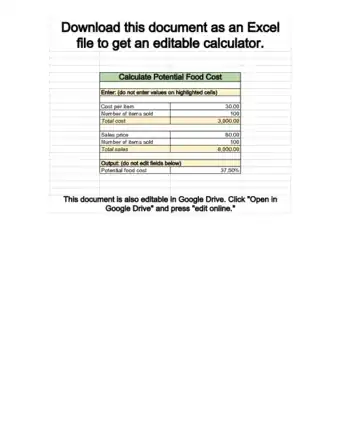
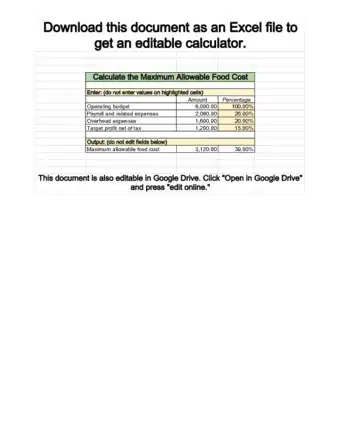

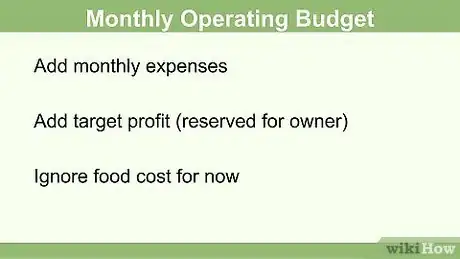

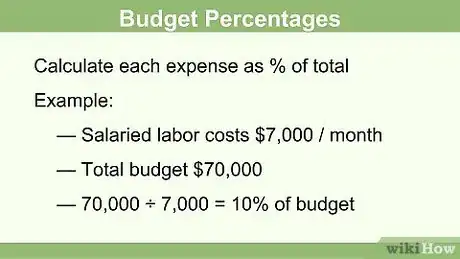
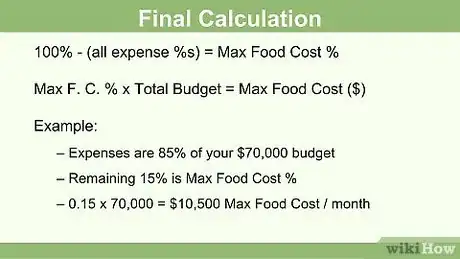
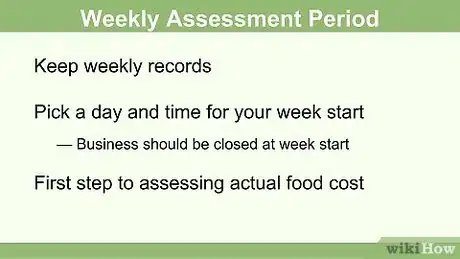
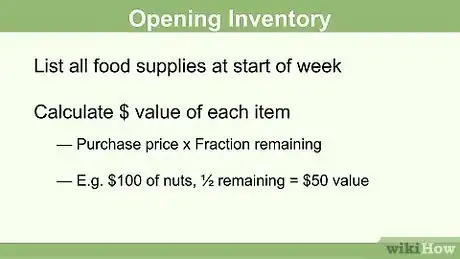

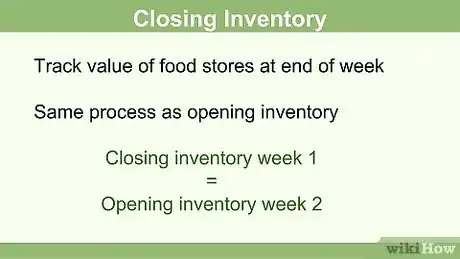
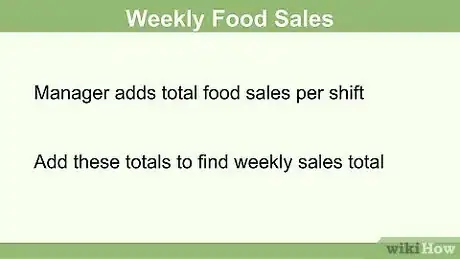

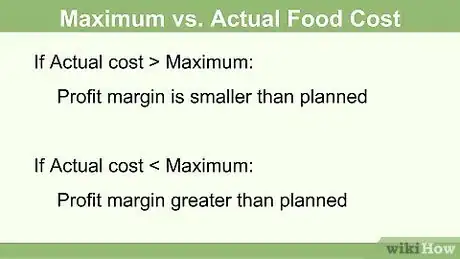
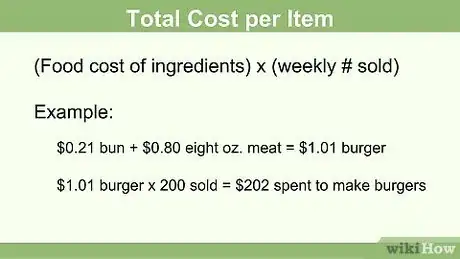
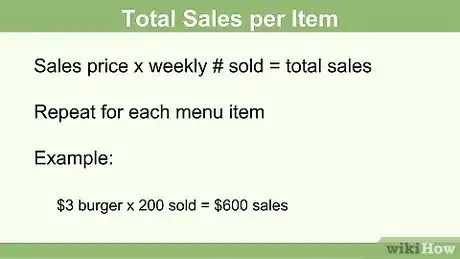
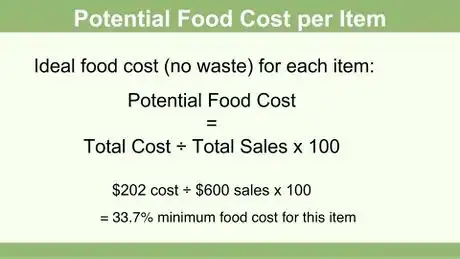










-Step-7-Version-3.webp)









